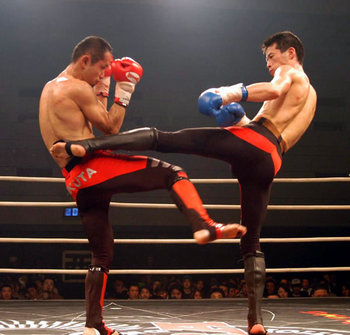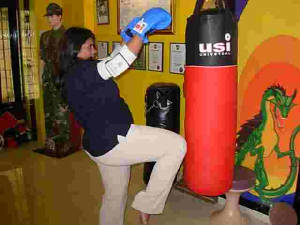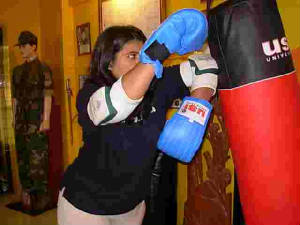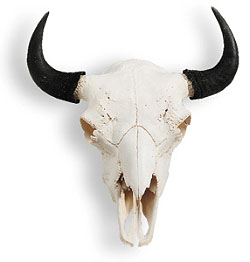|
|
 |
|
ACADEMY OF COMBAT FITNESS
Mumbai Centers 9820496752 or 9969022229 (Monica)

 

Muay Thai is Thailands national sport. Traditional
Muay Thai practiced today uses kicks and punches in a ring with gloves similar to those used in Western Boxing. Muay Thai
is referred to as "The Science of Eight Limbs", as the hands, shins, elbows and
knees are all used extensively in this art. A master practitioner of Muay Thai thus has the ability to execute strikes using
eight "points of contact," as opposed to "two points" (fists) in Western boxing and "four points" (fists, feet) used in the
primarily sport-oriented martial arts
Formal
Muay Thai techniques are divided into two groups: Mae Mai or major techniques and Luk Mai or minor techniques.
The basic offensive techniques in Muay Thai use punching fists,
elbows, shins and knees to strike the opponent. To bind the opponent for both offensive and defensive purposes, small amounts
of grappling and clinch is used. Almost all techniques in Muay Thai use the entire
body movement, rotating the hip with each kick, punch, and block. The rotation of the hips in Muay Thai techniques, is what
sets Muay Thai apart from other styles of martial arts.
Punching techniques (chok)
The
Punch techniques in Muay Thai are jab, straight right/cross, hook, uppercut, shovel and corkscrew punches plus overhand or
bolo punches
As
a tactic, body punching is used less in Muay Thai than other martial arts to avoid exposing the attacker's head to counter
strikes from knees or elbows.
Elbow techniques
(sawk)
The
elbow can be used in seven ways: horizontal, diagonal-upwards, diagonal-downwards, uppercut, downward, backward-spinning and
flying. This is the most common way of using the elbow. The diagonal elbows are faster than the other forms, but are less
powerful. The uppercut and flying elbows are the most powerful, but are slower and easier to avoid or block. The downward
elbow is usually used as a finishing move.
The
single elbow is an elbow move independent from any other move, whereas a follow-up elbow is the second strike from the same
arm, being a hook first with an elbow follow-up. Elbows, are used when the distance between fighters becomes too small and
there is too little space to throw punches at the opponent's head.
Kicking techniques
The
two most common kicks in Muay Thai are known as the teep (literally "foot jab,"), and the Angle kick i.e. TAE(kick)chieng(kicking
upwards in the shape of a triangle cutting under the arm and ribs) or. The Muay Thai angle kick has been widely adopted by
fighters from other martial arts. The angle kick similar to a karate roundhouse kick uses a rotational movement of the entire
body. The angle kick draws it's power entirely from the rotational movement of the body. Many Muay Thai fighters use a counter
rotation of the arms to intensify the power of this kick.
A
Thai fighter uses this to his advantage, and if a round house kick is attempted by the opponent the fighter will block foot
with his shin. Thai boxers are trained to always connect with the shin. While sensitive in an unconditioned practitioner,
the shin is the strongest part of the leg for experienced Muay Thai fighters. The foot contains many fine bones and is much
weaker.
Muay
Thai also includes other varieties of kicking, such as the axe kick, side kick or spinning back kick etc.
In
Muay Thai, a side kick is executed by first raising the knee of the leg that is going to kick in order to convince the opponent
that the executor is going to perform a teep or front kick. The hips are then shifted to the side to the more traditional
side kick position for the kick itself. The "fake-out" always precedes the kick in Muay Thai technique.
Knee techniques("kao")
- Kao
Dode (Jumping knee strike) -
the Thai boxer jumps up on one leg and strikes with that leg's knee.
- Kao
Loi (Flying knee strike) - the
Thai boxer takes step(s), jumps forward and off one leg and strikes with that leg's knee.
- Kao
Tone (Straight knee strike)
- the Thai boxer simply thrusts it forward (not upwards,
- Kao
Noi (Small knee strike) - the
Thai boxer hits the inside upper thigh (above the knee) of the opponent when clinching. This technique is used to wear down
the opponent or to counter the opponent's knee strike or kick.
The Clinch
The proper clinch technique employs controlling the back and top of the opponents head, not the neck,
which in fact is much harder to control.
It
is often in the clinch where knee techniques are used. The front clinch should be performed with the palm of one hand on the
back of the other A correct clinch also involves your forearms pressing against the other fighter's collar bone while your
hands are around the opponent's head rather than his neck. The general way to get out of a clinch (not the one pictured) is
to push the opponents head backwards or elbow him, as the clinch requires both participants to be very close to one another.
Additionally, the non-dominant clincher can try to "swim" his arm underneath and inside his opponent's clinch, establishing
him as the now dominant clincher.
Muay
Thai has several other variants of the clinch, including:
- arm clinch, where one or both hands controls the inside of the defender's arm(s) and where the second hand if free isin the front
clinch position, this clinch isused to briefly control the opponent beforeapplying a knee strike or throw
- side clinch, one arm passing around the front of the defender with the attacker's sholder pressed into the defender's arm pit and
the other arm passing round the back which allows the attacket to apply knee stikes to the defender's back or to throw the
defender readily
- low clinch, with both controlling arms passing under the defender's arms, which is generally used by the shorter of two opponents
- swan-neck where one hand around the rear of the neck is used to briefly clinch (before a strike) an opponent.
Defence against attacks
Defences
in Muay Thai are categorised in 6 groups:
- Blocking
- defender's hard blocks to stop a strike in its path so preventing it reaching its target, (eg the Shin Block described in
more detail below)
- Redirection
- defender's soft parries to change the direction of a strike (eg a downwards tap to a jab) so that it misses the target
- Avoidance
- moving a body part out of the way or range of a strike so the defender remains in range for a counter-strike, eg defender
moving the front leg backwards from the attacker's low kick: then immediately counter-attacking with an angle kick: or defender
laying the head back from the attacker's high angle kick: then immediately counter-attacking with a side kick from the front
leg:
- Evasion
- moving the body out of the way or range of a strike so the defnder has to move close again to counter-attack, eg defender
jumping back from attacker's kicks
- Disruption
- Pre-empting an attack. eg with defender using disruptive techniques like jab, teep or low angle kick (to the inside of the
attacker's front leg) as the attacker attempts to close distance
- Anticipation
- Defender catching a strike (eg catching a angle kick to the body)or countering it before it lands (eg defender's low kick
to the supporting leg below as the attacker iniates a high angle kick).
Defence against attacks - punches
and kicks
Defensively,
the concept of "wall of defence" is used, in which shoulders, arms and legs are used to hinder the attacker from successfully
executing his techniques.
Low
and mid body roundhouse kicks are normally blocked with the upper portion of a raised shin.
High
body strikes are blocked with the forearm/glove, elbow/shin.
Mid
section roundhouse kicks can also be caught/trapped, allowing for a sweep or counter attack to the remaining leg of the opponent.
Punches
are blocked with an ordinary boxing guard
A
common means of blocking a punch is using the hand on the same side as the oncoming punch to redirect the punch's angle with
his right hand.
Hooks
are most often blocked with a motion most often described as "combing your hair," raising the elbow forward and effectively
shielding the head with the forearm, flexed bicep, and shoulder.
Ref
Wiki pedia
|
 |
|
|
|
Enter supporting content here
FOR CONTACT INFO
SCROLL DOWN TO BOTTOM OF SITE
Salient
Features of
ACADEMY OF COMBAT FITNESS:
(For Contact details see below at Site footer)
· SOPHISTICATED EQUIPMENT (Chinese Dummy, Power Bags, Speed Balls, etc)
· ONE Instructor FOR ONE Student
· PROTECTED FIGHTING (Full Body Gear)
· Learn to fight in STEP by STEP Stages
· Under SAFE & EXPERT Supervision!
· International CURRICULUMS
· AWARDED CERTIFICATES (World Recognzd)
· DIETETICS & WEIGHT MGT (Improve Diet)
· FITNESS & WEIGHT TRG (Lose Fat, get Fit)
· LEARNING WITH VIDEO & MEDIA (Study)
· EXTENSIVE LIBRARY, JOURNALS (Projects)
· HUMAN BODY STRUCTURE, FUNCTION
· FIRST AID, CPR, PRIMARY MEDICINE (+)
· MEDICAL HELP & CONSULTS (Free!)
· PHILOSOPHY DEVELOPMENT
· MEDITATION, CONCENTRATION & YOGA
· SELF HYPNOSIS & VISUALIZATION
CONTACT DETAILS:
COMBAT CENTERS:
South Mumbai (Opera House, Charni
Road)
Western Suburbs (Andheri West JP Road)
Eastern Suburbs (Kandivalli Thakur Village)
Contact
Us:
Call 9820496752
or 9969022229
(Monica)
CENTERS
- HQ - ANDHERI (W)
- CHARNI ROAD
- KANDIVALI (E)
- THANE (Ghodbunder Road)
This Website Address
w w w. JKDindia .c o m
If U
Wanna learn to fight
Better learn from the best!
BOTTOMNOTE:
Martial Arts are the art of bare handed combat between two individuals. Martial Arts in our school in Bombay Mumbai
India like Kickboxing, Karate, Taekwondo, Hapkido, Judo, Boxing, Wrestling, Isreali Krav Maga, BJJ, Wing Chun, Shaolin Kung
Fu, Ninja, Jiu Jutsu / Jitsu, jeet Kune Do JKD, Filipino Philipino Martial arts, Kali, Arnis, Escrima, Silat, Capoeira, Self
Defense Defence for Women & Ladies are all modern day martial arts. These arts are taught only at our academy in a scientific
way. Martial Arts in our school in Bombay Mumbai India like Kickboxing, Karate, Taekwondo, Hapkido, Judo, Boxing, Wrestling,
Isreali Krav Maga, BJJ, Wing Chun, Shaolin Kung Fu, Ninja, Jiu Jutsu / Jitsu, jeet Kune Do JKD, Filipino Philipino Martial
arts, Kali, Arnis, Escrima, Silat, Capoeira, Self Defense Defence for Women & Ladies are taught with absolute safety and
concern. Martial Arts in our school in Mumbai India like Kickboxing, Karate, Taekwondo, Hapkido, Judo, Boxing, Wrestling,
Isreali Krav Maga, BJJ, Wing Chun, Shaolin Kung Fu, Ninja, Jiu Jutsu / Jitsu, jeet Kune Do JKD, Filipino Philipino Martial
arts, Kali, Arnis, Escrima, Silat, Capoeira, Self Defense Defence for Women & Ladies are taught with personal attention
and one on one personalized training. Martial Arts in our school in Mumbai India like Kickboxing, Karate, Taekwondo, Hapkido,
Judo, Boxing, Wrestling, Isreali Krav Maga, BJJ, Wing Chun, Shaolin Kung Fu, Ninja, Jiu Jutsu / Jitsu, jeet Kune Do JKD, Filipino
Philipino Martial arts, Kali, Arnis, Escrima, Silat, Capoeira, Self Defense Defence for Women & Ladies is taught by worldwide
authentic experts at our academy. Martial Arts in our school in Mumbai India like Kickboxing, Karate, Taekwondo, Hapkido,
Judo, Boxing, Wrestling, Isreali Krav Maga, BJJ, Wing Chun, Shaolin Kung Fu, Ninja, Jiu Jutsu / Jitsu, jeet Kune Do JKD, Filipino
Philipino Martial arts, Kali, Arnis, Escrima, Silat, Capoeira, Self Defense Defence for Women & Ladies is taught under
medical supervision to avoid injury and ensure maximum fitness. For learning Martial Arts in our school in Mumbai India like
Kickboxing, Karate, Taekwondo, Hapkido, Judo, Boxing, Wrestling, Isreali Krav Maga, BJJ, Wing Chun, Shaolin Kung Fu, Ninja,
Jiu Jutsu / Jitsu, jeet Kune Do JKD, Filipino Philipino Martial arts, Kali, Arnis, Escrima, Silat, Capoeira, Self Defense
Defence for Women & Ladies you have to approach us. After all if you wanna learn to fight, better learn from the best.
Dr Seema Rao
|
|
|
 |

